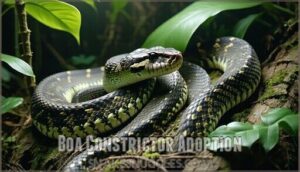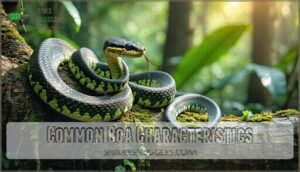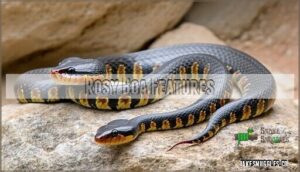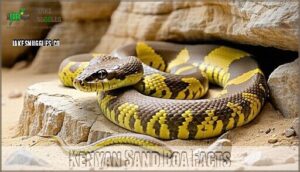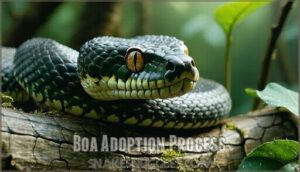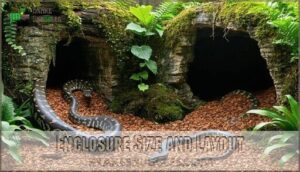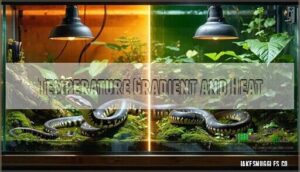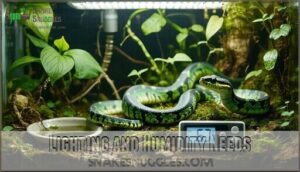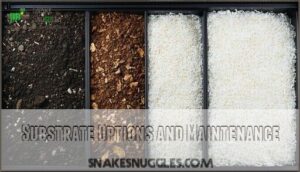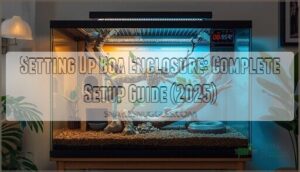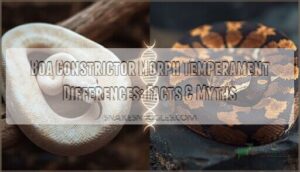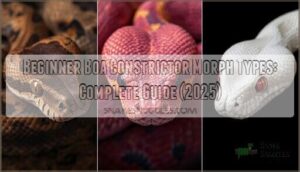This site is supported by our readers. We may earn a commission, at no cost to you, if you purchase through links.
 To find boa constrictor adoption near you, start with specialized reptile rescues rather than pet stores.
To find boa constrictor adoption near you, start with specialized reptile rescues rather than pet stores.
These organizations rehabilitate unwanted snakes and carefully match them with suitable homes. You’ll need to complete an application process that often requires habitat photos and care plans.
Check with local herpetological societies, exotic animal rescues, and reptile-focused Facebook groups in your area.
Most adoptable boas come with complete health records and feeding histories, giving you peace of mind about your new pet’s condition.
Proper enclosure setup is essential – these impressive creatures need specific temperature zones and adequate space to thrive in your care.
Table Of Contents
- Key Takeaways
- Boa Constrictor Adoption
- Choosing Right Boa Species
- Boa Adoption Process
- Boa Care and Housing
- Post Adoption Support
- Frequently Asked Questions (FAQs)
- Where to send unwanted reptiles?
- What to do with unwanted reptiles?
- How do you adopt a snake from snake Discovery?
- How do I adopt a reptile in San Diego?
- How big should a boa constrictor enclosure be?
- How much does a boa constrictor snake cost?
- Can baby boa constrictors be housed in glass aquariums?
- Does a baby Boa constrict?
- What are the different types of boa constrictors?
- Can I adopt a Columbian Boa from Snake Haus?
- Conclusion
Key Takeaways
- Check local reptile rescues and herpetological societies for adoption options, as they often rehome unwanted boas with proper care guidelines.
- Prepare a proper enclosure with minimum dimensions of 6′ x 2′, temperature zones, proper humidity, and secure locks before adopting a boa.
- Expect to complete an application, provide photos of the setup, and possibly undergo a home visit to meet adoption requirements.
- Join reptile communities or forums for ongoing support, care tips, and guidance to ensure a smooth long-term experience with your boa.
Boa Constrictor Adoption
You’ll find boa constrictor adoption offers a rewarding way to give these magnificent reptiles a second chance at a loving home.
Local reptile rescues regularly take in unwanted or surrendered boas that need experienced owners who can provide proper enclosures, temperature control, and appropriate feeding schedules, which is a key part of reptile care.
Researching Local Reptile Rescues
Curious about boa constrictor adoption? Start by researching reptile rescues. A reputable rescue guarantees ethical practices and proper care.
Follow these steps:
- Search "reptile rescue near me."
- Check surrender policies and species accepted.
- Verify rescue reputation through reviews or certifications.
- Confirm their adoption radius fits your location.
- Explore volunteer opportunities for firsthand insight to gain a deeper understanding of the adoption process and the rescue’s reputation.
Checking Adoption Requirements
Before diving into boa constrictor adoption, you’ll need to meet specific requirements.
Most rescues require age verification (18+), completing an online application at their website, and signing a no-breeding agreement.
Be prepared for potential home visits as part of the screening process.
Reptile adoption requirements vary by organization, and they reserve the right to deny applications that don’t meet their standards for proper snake care.
Preparing for Boa Care
Before bringing home your boa constrictor, you’ll need proper setup ready.
Now that you’ve checked adoption requirements, it’s time to prepare your space.
- Enclosure: Get a habitat at least 6′ long × 2′ wide with secure, latched doors
- Temperature: Install under-tank heater or heat panel with digital thermostat
- Hides: Place one hide on warm side, another on cool side
- Diet: Stock frozen/thawed prey; never feed live animals
Maintaining proper humidity levels is also essential for healthy shedding.
Choosing Right Boa Species
You’ll need to select the right boa species that matches your experience level and home setup before adoption.
Different boa types have unique size requirements, temperaments, and care needs that directly impact their suitability for your specific situation, and understanding these factors is crucial for making an informed decision about which boa to adopt.
Common Boa Characteristics
Now that you’re considering adoption, let’s look at what makes common boas unique.
Boa constrictors display distinctive characteristics you’ll want to understand before bringing one home.
| Feature | Characteristic | Care Consideration |
|---|---|---|
| Boa Size | Adults reach 8-10 ft | Requires large enclosure |
| Boa Lifespan | 20-30 years wild, 35+ captivity | Long-term commitment |
| Boa Temperament | Calm, solitary nature | Regular handling needed |
They’re generally docile but will hiss when threatened.
Their heat-sensing pits make them efficient hunters in their natural habitat, which is a key aspect of their wild behavior and natural habitat.
Red-Tailed Boa Traits
While common boas share family traits, red-tailed boas stand out with their distinctive features.
You’ll recognize them by their tan or brown bodies with darker saddle patterns and their namesake reddish tails.
- These gentle giants can reach 10 feet in length, with females growing larger
- Their docile temperament makes them popular for first-time boa owners
- Their color changes as they mature, from grayish babies to yellow adults
- They require consistent handling to maintain their friendly disposition
Rosy Boa Features
When considering reptile adoption near me, Rosy Boas stand out with three distinct longitudinal stripes on their bodies.
You’ll find these gentle snakes reach 17-44 inches, making them perfect for first-time owners.
| Feature | Characteristic |
|---|---|
| Size | 17-44 inches, females larger |
| Color morphs | Stripes in black, brown, orange on gray/tan |
| Temperament traits | Slow-moving, docile nature |
| Activity | Nocturnal, speeds up to 1 mph |
| Reproduction | Live birth after 4-month gestation |
Kenyan Sand Boa Facts
Kenyan Sand Boas stand out as perfect starter snakes in reptile adoption.
They’re naturally camouflaged with mottled yellow and brown patterns.
Their temperament overview: generally docile but spend most time burrowed.
Their habitat needs are simple—a sand-soil mix and 72-95°F temperature gradient.
Their feeding habits include ambushing small prey, sometimes surviving a year without food, which makes them low-maintenance pets with a simple care routine, allowing them to thrive in smaller spaces with a suitable temperature gradient.
Boa Adoption Process
You’ll need to complete an application and meet specific requirements before bringing home your new boa constrictor.
Most rescues require you to be at least 18 years old and will conduct screening to guarantee you can provide proper care for these specialized pets.
Finding Reputable Breeders
After choosing the right boa species for your lifestyle, you’ll need to locate quality breeders.
Look for reptile adoption organizations with strong online presence and positive reviews. Check if they provide health records and genetic history for their boa constrictors.
Ethical breeding practices matter – avoid breeders who only showcase morphs. Verify breeder reputation through Facebook groups or reptile expos.
Quality breeders prioritize lineage tracking and offer health guarantees.
Scheduling Meet and Greet
Now that you’ve found potential breeders, it’s time to arrange your meet and greet.
Contact the rescue to set up a visit where you can assess the boa’s temperament firsthand.
Bring a list of health questions and handling concerns.
During your visit, observe how the snake reacts to being handled, understanding their defensive behaviors is essential for a safe interaction.
This interaction helps determine your adoption readiness and whether this particular boa constrictor is right for you.
Health and Wellness Checks
Your boa’s health status is vital before finalizing any adoption.
Based on the style and tone of the article, here’s an engaging blockquote:
Health assessment is your first duty to any boa you welcome into your home—their wellbeing cannot wait.
Check for clear eyes, intact skin, and regular tongue flicking – all signs of good health.
Watch for respiratory infections (wheezing or mucus) and examine the snake’s body for injuries or abnormalities.
Discuss parasite prevention and shedding problems with the rescue.
Many reputable facilities implement quarantine protocols to guarantee snakes are healthy before adoption.
This careful assessment protects both you and your new pet.
Finalizing Adoption
Once you’ve selected your boa, you’ll need to complete the final adoption paperwork.
Most snake adoption organizations require signing legal agreements about proper care. Be prepared to pay adoption fees, which typically range from $50-200 depending on the reptile adoption organization.
Before leaving, confirm transport planning details and schedule your post-adoption checkup. Many boa constrictor adoption processes include follow-up support to guarantee your new pet thrives.
Boa Care and Housing
You’ll need a proper home for your boa with the right temperature, humidity, and space for it to thrive.
Your enclosure should measure at least 6 feet long by 2 feet wide with secure walls, adequate ventilation, and both warm and cool hiding spots.
Enclosure Size and Layout
Your boa constrictor’s home requires minimum dimensions of 6′ long × 2′ wide, with adjustments based on your snake’s size.
Provide vertical space for climbing with solid-walled enclosures that have proper ventilation.
Include at least two hides (one warm, one cool) and make certain adequate substrate depth for burrowing.
Water access is essential—use a dish large enough for submersion. Consider appropriate habitat products for your snake.
Secure your snake habitat design with latching doors or locked screens to prevent escapes.
Temperature Gradient and Heat
Now that you’ve set up the right enclosure, let’s talk about keeping your boa at the perfect temperature.
Proper heat management is a cornerstone of boa constrictor care.
- Hot spot temperature should stay between 88-92°F for ideal digestion
- Cool side should maintain 78-82°F for thermoregulation options
- Night temperatures can drop to 75-80°F safely
- Ambient temperature throughout the enclosure should remain above 75°F
- Surface temperatures must never exceed 95°F to prevent burns
Always use thermostats with your heat sources to prevent dangerous overheating.
Adequate boa enclosure size is vital for maintaining these gradients.
Lighting and Humidity Needs
Managing your boa constrictor’s lighting and humidity needs is essential for proper health and shedding.
Unlike some reptiles, boas don’t require UVB lighting but need consistent humidity levels.
| Humidity Requirement | Monitoring Tool | Maintenance Method |
|---|---|---|
| 50-60% (daily) | Hygrometer placement | Regular misting |
| 60-70% (shedding) | Digital hygrometer | Large water dish |
| 40-50% (arid species) | Humidity gauge | Damp hide box |
| 65-75% (tropical species) | Remote sensors | Automated misting systems |
| 55-65% (average) | Combo thermometer/hygrometer | Manual spraying |
Low humidity causes shedding issues while excessive moisture creates respiratory problems.
You can find a suitable humidity reader at many online retailers, which is crucial for maintaining the right environment for your boa constrictor.
Substrate Options and Maintenance
With the right humidity established, you’ll need proper substrate to complete your boa’s home. Choose safe options that maintain moisture without causing health issues.
- Cypress mulch retains humidity well and resists mold growth
- Paper towels offer easy cleaning for quarantine periods
- Coconut husk provides natural burrowing opportunities
- Reptile-specific soil mixes create a naturalistic environment
Clean spot-messes daily and replace substrate monthly to prevent bacteria growth. Consider cypress mulch options when setting up your boa’s enclosure.
The right substrate balances humidity control while minimizing impaction risks for your adopted boa constrictor.
Post Adoption Support
You’ll need ongoing support after bringing your new boa constrictor home. Many reptile rescues offer post-adoption resources including healthcare advice, feeding guidance, and emergency assistance for new snake owners.
Building Support Network
After setting up proper housing for your new boa, you’ll need people who understand these reptiles.
Connect with experienced boa owners through online forums like reptile rescue forums and snake adoption forums.
Find local herpetologists who can provide adopter mentorship.
Keep veterinary contacts specialized in reptiles on speed dial.
Join the reptile community on social media for boa constrictor adoption advice.
Remember that many snakes require specific temperature gradients to thrive.
Your pet adoption support network makes all the difference in successful snake keeping.
Dealing With Emergencies
Everyone faces emergencies with their adopted boa constrictors at some point.
Keep a reptile-specific first aid kit handy for snake bites and know how to respond calmly.
Have a backup heat source ready for power outages.
Monitor for respiratory issues, scale rot, and enclosure breaches daily.
Contact information for your local exotic pet rescue or reptile rescue should be prominently displayed near your snake’s habitat for quick reference during emergencies, and always be prepared to handle a snake bite.
Long-Term Commitment Planning
Most boa constrictors live 20-30 years, requiring long-term commitment planning from day one.
Your financial implications include ongoing costs for food, habitat upgrades, and veterinary care.
Consider space requirements as your snake grows and how future relocations might affect both of you.
Always have caregiver alternatives identified in case of emergency. The adoption process isn’t just about today—it’s about embracing pet responsibilities and lifestyle changes for decades.
Ongoing Boa Care Education
Now that you’re committed to your boa’s lifelong care, continued education will keep you both thriving.
Subscribe to reptile forums where experienced owners share handling techniques and shedding assistance tips. Learn to recognize illness early through online boa constrictor care resources.
Join reptile Facebook groups to discover enrichment activities and dietary adjustments as your snake ages. Your knowledge should grow alongside your scaly companion. You should focus on reptile forums and online boa constrictor care resources to ensure the best care for your boa.
Frequently Asked Questions (FAQs)
Where to send unwanted reptiles?
You can surrender unwanted reptiles to specialized rescue centers like Phoenix Herpetological Sanctuary, Georgia Reptile Society, or Forgotten Friend Reptile Rescue.
These organizations rehabilitate and find new homes for your scaly friend.
What to do with unwanted reptiles?
When life throws you a scaly curveball, contact reptile rescue organizations like Forgotten Friend or Phoenix Herpetological Sanctuary. You can surrender unwanted reptiles for rehabilitation and adoption to experienced homes.
How do you adopt a snake from snake Discovery?
To adopt a snake from Snake Discovery, visit their adoption website, review available snakes, and complete the online application.
Verify you meet their requirements, including proper enclosure setup and care knowledge.
Pickup arrangements are required.
How do I adopt a reptile in San Diego?
Adopting a reptile in San Diego feels like finding the perfect puzzle piece.
Visit rescues like Ecovivarium or check local reptile groups.
Research care needs, sign agreements, and verify you’re ready for a lifelong commitment.
How big should a boa constrictor enclosure be?
A boa constrictor needs an enclosure at least 6 feet long and 2 feet wide.
Aim for solid walls with good ventilation, secure doors, and space for both climbing and hiding to guarantee comfort.
How much does a boa constrictor snake cost?
Buying a boa constrictor can cost $50 to $300, depending on age, size, and morph.
Specialty morphs or rare colors might run higher.
Always budget for proper enclosure, heating, and care supplies too!
Can baby boa constrictors be housed in glass aquariums?
You can house baby boa constrictors in glass aquariums if you guarantee proper ventilation, secure lids, and consistent temperatures.
Use an under-tank heater with a thermostat and add hides to reduce stress.
Does a baby Boa constrict?
Did you know baby boas are born ready to constrict?
They instinctively use this natural behavior to subdue prey like small rodents, though their grip isn’t as strong as adults.
It’s remarkable how nature equips them!
What are the different types of boa constrictors?
You’ll find several types of boa constrictors, like the red-tailed boa, common boa, and rosy boa.
Each has unique patterns, sizes, and care needs, making it important to research before choosing one, especially considering the complete concepts of their needs.
Can I adopt a Columbian Boa from Snake Haus?
Taking the plunge into adopting a Columbian Boa from Snake Haus depends on availability and your readiness for their care.
Check directly with Snake Haus to confirm their current rescue roster and adoption guidelines.
Conclusion
Did you know boa constrictors can live up to 30 years in proper care?
When considering "boa constrictor adoption near me," take time to research reputable rescues and understand these amazing reptiles’ needs.
From setting up a suitable enclosure to meeting their temperature and feeding requirements, your preparation guarantees a healthy, happy pet.
Remember, adopting a boa is a long-term commitment, so build a support network and stay informed to ensure you can provide the best life for your pet, and your perfect snake companion is waiting!

